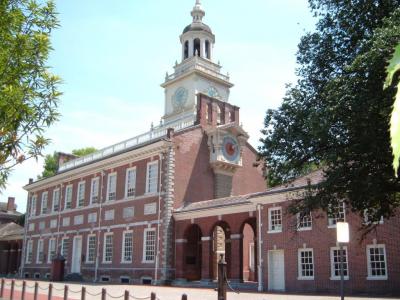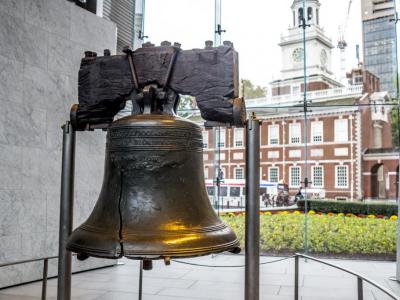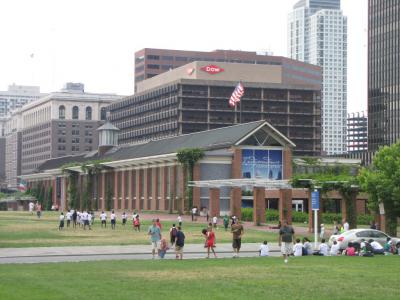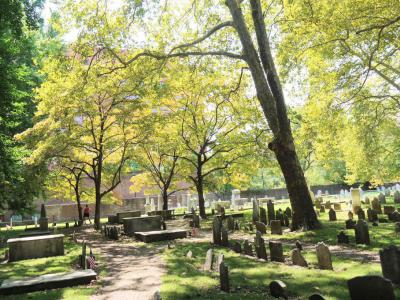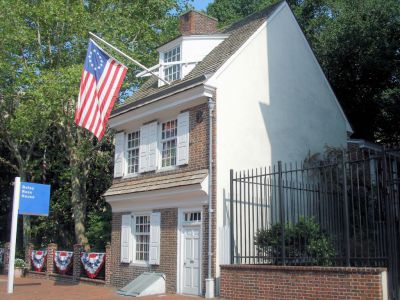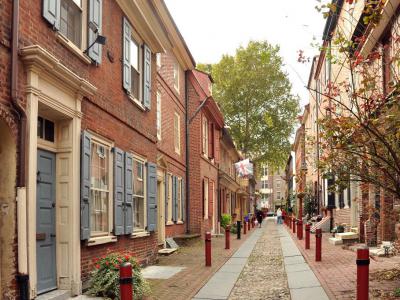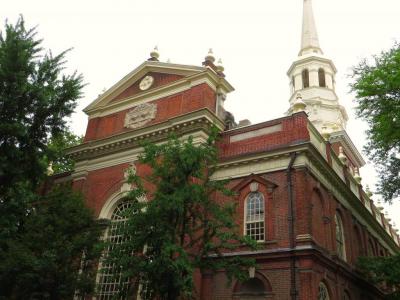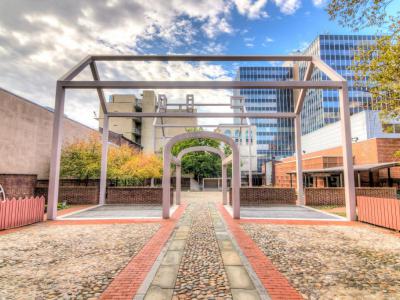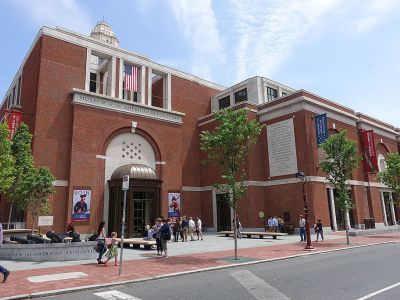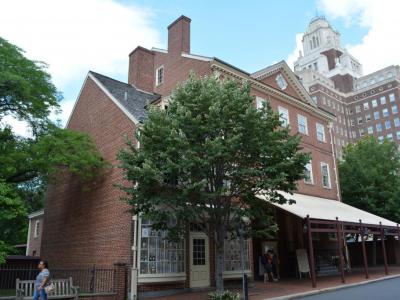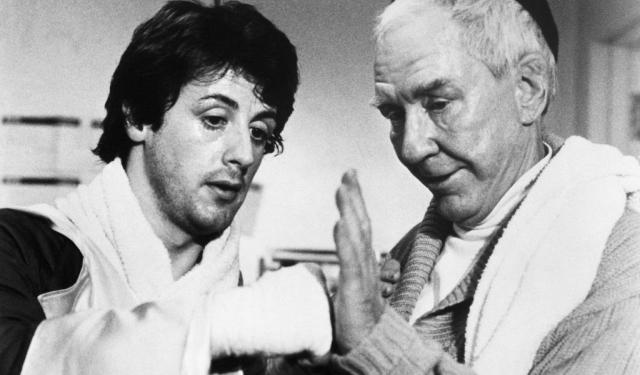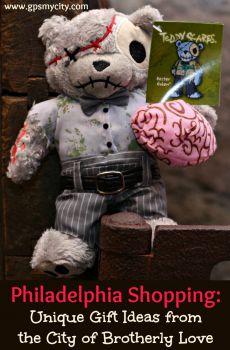
Philadelphia Old City Walking Tour (Self Guided), Philadelphia
King Charles II of England owed a lot of money to Admiral Sir William Penn. He paid in 1681 by signing over lands in America to the Admiral's son, William Penn. Young William, a Quaker and a thorn in the side of the King, became landlord of present-day Pennsylvania and Delaware. William sailed up Delaware, laid out a grid, and founded Philadelphia.
The streets of the grid run east and west between the Delaware and Schuylkill rivers. This is the Old City Center, the most historic section of Philadelphia. It is home to Independence National Historical Park, Independence Hall, the Liberty Bell, the Banks of the United States, Carpenters' Hall, Betsy Ross House, and Elfreth's Alley.
Old City has many historical attractions. Christ Church built in 1695, Arch Street Meeting House built in 1701, and Old First Reformed Church built in 1727 grace the area. There are also fine examples of Federal and Georgian architecture. Greek Revival and Italianate banks and cast iron warehouses add to the visitor's list of things to see. The modern Museum of the American Revolution is here and so is the National Constitution Center.
The Old City is a favorite nightlife watering hole. Lounges, dive bars, and restaurants populate the blocks from 3rd and Market to Front and Chestnut. Boutiques, galleries, and art film theaters operate in the neighborhood. During the First Friday events, the studios, galleries, and shops have evening open houses.
William Penn hoped to found a Utopia of tolerance in the new world. One can get a glimpse of that dream when visiting the City of Brotherly Love.
The streets of the grid run east and west between the Delaware and Schuylkill rivers. This is the Old City Center, the most historic section of Philadelphia. It is home to Independence National Historical Park, Independence Hall, the Liberty Bell, the Banks of the United States, Carpenters' Hall, Betsy Ross House, and Elfreth's Alley.
Old City has many historical attractions. Christ Church built in 1695, Arch Street Meeting House built in 1701, and Old First Reformed Church built in 1727 grace the area. There are also fine examples of Federal and Georgian architecture. Greek Revival and Italianate banks and cast iron warehouses add to the visitor's list of things to see. The modern Museum of the American Revolution is here and so is the National Constitution Center.
The Old City is a favorite nightlife watering hole. Lounges, dive bars, and restaurants populate the blocks from 3rd and Market to Front and Chestnut. Boutiques, galleries, and art film theaters operate in the neighborhood. During the First Friday events, the studios, galleries, and shops have evening open houses.
William Penn hoped to found a Utopia of tolerance in the new world. One can get a glimpse of that dream when visiting the City of Brotherly Love.
How it works: Download the app "GPSmyCity: Walks in 1K+ Cities" from Apple App Store or Google Play Store to your mobile phone or tablet. The app turns your mobile device into a personal tour guide and its built-in GPS navigation functions guide you from one tour stop to next. The app works offline, so no data plan is needed when traveling abroad.
Philadelphia Old City Walking Tour Map
Guide Name: Philadelphia Old City Walking Tour
Guide Location: USA » Philadelphia (See other walking tours in Philadelphia)
Guide Type: Self-guided Walking Tour (Sightseeing)
# of Attractions: 10
Tour Duration: 2 Hour(s)
Travel Distance: 2.4 Km or 1.5 Miles
Author: leticia
Sight(s) Featured in This Guide:
Guide Location: USA » Philadelphia (See other walking tours in Philadelphia)
Guide Type: Self-guided Walking Tour (Sightseeing)
# of Attractions: 10
Tour Duration: 2 Hour(s)
Travel Distance: 2.4 Km or 1.5 Miles
Author: leticia
Sight(s) Featured in This Guide:
- Independence Hall
- Liberty Bell
- Independence National Historical Park
- Christ Church Burial Ground
- Betsy Ross House
- Elfreth's Alley
- Christ Church
- Benjamin Franklin Museum and Court
- Museum of the American Revolution
- City Tavern
1) Independence Hall (must see)
In 1729 it was becoming evident that Philadelphia needed a state house. In August 1732, the Scottish lawyer Andrew Hamilton showed his plans to the Provincial Assembly. The ground was broken for construction soon after in Philadelphia. The State House would be on the south side of Chestnut Street between Fifth and Sixth Streets. The cost was to be about 2,000 pounds.
The Colonial Government of Pennsylvania took occupancy of the State House immediately. Construction was designed and built by architect Edmund Woolley. The building proceeded piecemeal as funds were allocated. The State House was completed in 1753. It served as the Capitol of the Province and Commonwealth of Pennsylvania until 1799.
Independence Hall is a Georgian-style hall with a red brick facade. There is a central building with a bell tower and steeple. The center is attached by arcaded passageways to wings on either side. The steeple spire is 169 feet high. Old City Hall, Congress Hall, and Independence Hall together with Philosophical Hall, share Independence Square.
The Hall underwent several renovations in the 19th and 20th centuries. In the mid-20th century, the National Park Service carried out a reconstruction to restore the Hall to its 18th-century appearance. On the ground floor are the Assembly Room and the Supreme Court Room, separated by a vestibule. Behind the entrance is the Tower Stair Hall.
From 1775 to 1783, the Pennsylvania State House was the main meeting house of the Second Continental Congress. The Declaration of Independence was approved within its walls on July 4, 1776. Congress had to abandon the State House from time to time as British forces occupied Philadelphia. The United States Constitution was approved here in 1787.
Independence Hall has often served as a venue for speeches, rallies, and protests. Most events have been held on behalf of democratic and civil rights movements.
The Colonial Government of Pennsylvania took occupancy of the State House immediately. Construction was designed and built by architect Edmund Woolley. The building proceeded piecemeal as funds were allocated. The State House was completed in 1753. It served as the Capitol of the Province and Commonwealth of Pennsylvania until 1799.
Independence Hall is a Georgian-style hall with a red brick facade. There is a central building with a bell tower and steeple. The center is attached by arcaded passageways to wings on either side. The steeple spire is 169 feet high. Old City Hall, Congress Hall, and Independence Hall together with Philosophical Hall, share Independence Square.
The Hall underwent several renovations in the 19th and 20th centuries. In the mid-20th century, the National Park Service carried out a reconstruction to restore the Hall to its 18th-century appearance. On the ground floor are the Assembly Room and the Supreme Court Room, separated by a vestibule. Behind the entrance is the Tower Stair Hall.
From 1775 to 1783, the Pennsylvania State House was the main meeting house of the Second Continental Congress. The Declaration of Independence was approved within its walls on July 4, 1776. Congress had to abandon the State House from time to time as British forces occupied Philadelphia. The United States Constitution was approved here in 1787.
Independence Hall has often served as a venue for speeches, rallies, and protests. Most events have been held on behalf of democratic and civil rights movements.
2) Liberty Bell (must see)
Since 2003, the Liberty Bell, formerly the State House Bell, has been kept in the Liberty Bell Center in Independence National Park. That's a short walk away from the Old State House, now Independence Hall. The bell was commissioned in 1752 by the Pennsylvania Provincial Assembly. They chose the London firm of Lester and Pack to do the casting.
The bell cracked the very first time it was tried. The local foundry operators, Pass and Stow, did the recasting. This was done twice. The recast bell was hung on the State House steeple. The crack reappeared in 1835 while tolling the death of Chief Justice John Marshall. The bell was brittle from faulty alloys of tin, pewter, and copper.
The Liberty Bell was used to ring on Independence Day, Washington's Birthday, and Election Day; and to summon legislators into session. In 1835 the bell was dubbed the "Liberty Bell" in the Anti-Slavery Record, an Abolitionist publication. Inscribed on the bell is the message: "Proclaim Liberty Throughout All the Land Unto All the Inhabitants thereof."
On April 1, 1996, Taco Bell announced it had bought the Liberty Bell and changed its name to "Taco Liberty Bell." They claimed the bell would be kept at Taco Bell's home office in Irvine, California. There was outrage, and Taco Bell had to admit it was an April fools' Day joke. The sale of enchiladas rose that week by $500,000.
The bell cracked the very first time it was tried. The local foundry operators, Pass and Stow, did the recasting. This was done twice. The recast bell was hung on the State House steeple. The crack reappeared in 1835 while tolling the death of Chief Justice John Marshall. The bell was brittle from faulty alloys of tin, pewter, and copper.
The Liberty Bell was used to ring on Independence Day, Washington's Birthday, and Election Day; and to summon legislators into session. In 1835 the bell was dubbed the "Liberty Bell" in the Anti-Slavery Record, an Abolitionist publication. Inscribed on the bell is the message: "Proclaim Liberty Throughout All the Land Unto All the Inhabitants thereof."
On April 1, 1996, Taco Bell announced it had bought the Liberty Bell and changed its name to "Taco Liberty Bell." They claimed the bell would be kept at Taco Bell's home office in Irvine, California. There was outrage, and Taco Bell had to admit it was an April fools' Day joke. The sale of enchiladas rose that week by $500,000.
3) Independence National Historical Park (must see)
Independence National Historical Park in Philadelphia has been called "America's most historic square mile." Administered by the National Park Service, the 55 landscaped acres hold several often-visited historic sites within the Old City and Society Hill neighborhoods.
The heart of the Park is Independence Hall, the former Old State House of Philadelphia. This is where the Declaration of Independence and the Constitution of the United States were adopted. The first Continental Congress met in 1774 in Carpenters' Hall next door to Independence Hall, the home of the Second Continental Congress.
The Liberty Bell hangs in the Liberty Bell Center across from Independence Hall. The First Bank of the United States is in the Park. The Second Bank of the United States was closed down by President Andrew Jackson. Nearby is the City Tavern, a refuge of delegates and John Adams' favorite hangout.
The Park houses Franklin Court Museum dedicated to Benjamin Franklin. Another park resident is the United States Postal Service Museum. The three blocks immediately north of Independence Hall is Independence Mall. Besides the Liberty Bell Center, the Mall holds the National Constitution Center and George Washington's residence in his second term.
The first proposal for Independence National Historical Park was floated in 1915. Architects Albert Kelsey and David K. Boyd were driven to create a more sylvan locale for Independence Hall. The action was not taken until June 1948, when Congress authorized the creation of the Park. The Park is listed on the National Register of Historic Places.
The heart of the Park is Independence Hall, the former Old State House of Philadelphia. This is where the Declaration of Independence and the Constitution of the United States were adopted. The first Continental Congress met in 1774 in Carpenters' Hall next door to Independence Hall, the home of the Second Continental Congress.
The Liberty Bell hangs in the Liberty Bell Center across from Independence Hall. The First Bank of the United States is in the Park. The Second Bank of the United States was closed down by President Andrew Jackson. Nearby is the City Tavern, a refuge of delegates and John Adams' favorite hangout.
The Park houses Franklin Court Museum dedicated to Benjamin Franklin. Another park resident is the United States Postal Service Museum. The three blocks immediately north of Independence Hall is Independence Mall. Besides the Liberty Bell Center, the Mall holds the National Constitution Center and George Washington's residence in his second term.
The first proposal for Independence National Historical Park was floated in 1915. Architects Albert Kelsey and David K. Boyd were driven to create a more sylvan locale for Independence Hall. The action was not taken until June 1948, when Congress authorized the creation of the Park. The Park is listed on the National Register of Historic Places.
4) Christ Church Burial Ground
Christ Church Burial Ground in Philadelphia is an important early-American cemetery, which is still active. Despite the name, it is actually three blocks west of Christ Church. The land was acquired in 1719 when the church's property was full, and the new land was on what was back then considered the outskirts of town.
Christ Church is an Episcopal church founded in 1695, and it was the place of worship for many Revolutionary War participants, including George Washington.
Here is the final resting place of many historic national figures and prominent Philadelphians, including Benjamin Franklin and his wife Deborah, as well as four other signers of the Declaration of Independence: Benjamin Rush, Francis Hopkinson, Joseph Hewes, and George Ross. Two more signers (James Wilson and Robert Morris) are buried at Christ Church itself.
The Burial Ground is open to the public for a small fee. When the Burial Ground is closed, one can still view Benjamin Franklin's gravesite from the sidewalk at the corner of 5th and Arch Streets through a set of iron rails. The rail opening in the brick wall was added for public viewing in 1858 at the request of the Franklin Institute.
It is an old Philadelphia tradition for people to leave pennies at Franklin's resting place.
Further away from Franklin, the visitors can see a small but neatly kept space with lesser-known graves, some of which are also quite interesting.
Christ Church is an Episcopal church founded in 1695, and it was the place of worship for many Revolutionary War participants, including George Washington.
Here is the final resting place of many historic national figures and prominent Philadelphians, including Benjamin Franklin and his wife Deborah, as well as four other signers of the Declaration of Independence: Benjamin Rush, Francis Hopkinson, Joseph Hewes, and George Ross. Two more signers (James Wilson and Robert Morris) are buried at Christ Church itself.
The Burial Ground is open to the public for a small fee. When the Burial Ground is closed, one can still view Benjamin Franklin's gravesite from the sidewalk at the corner of 5th and Arch Streets through a set of iron rails. The rail opening in the brick wall was added for public viewing in 1858 at the request of the Franklin Institute.
It is an old Philadelphia tradition for people to leave pennies at Franklin's resting place.
Further away from Franklin, the visitors can see a small but neatly kept space with lesser-known graves, some of which are also quite interesting.
5) Betsy Ross House (must see)
The story goes that Mrs. Eizabeth Claypoole, also known as Betsy Ross, had a visit from George Washington in 1776. She persuaded him, some say, that a five-pointed star was better than a six-pointed star. Betsy was an upholsterer, and she had been making flags for the Pennsylvania Navy. Flags were her specialty.
True or not, this captivating tale was told by her grandsons, William and George Canby, in the 1870s. People loved it, and it became a popular national legend. Number 239 Arch Street in Philadelphia is where Betsy is said to have lived with her third husband, John Claypoole. The house is a restoration done by architect Richardson Okie in 1940.
The "Betsy Ross" house that stands today may have been the house used by Betsy for her business. The residence of Betsy and her husband was adjacent to the present house. The houses next door were demolished and turned into a courtyard.
Richardson Okie used materials from the demolished houses in his restoration. A brick structure was built behind the house. Windows and a dormer were replaced. The whole property was gifted to the city of Philadelphia in 1941. In 1974 the courtyard was provided with a fountain.
As part of the American Bicentennial of 1976, city authorities moved the remains of Betsy and her husband, John Claypoole. They were reinterred in the courtyard of the Betsy Ross House. Betsy is thought to have resided in the house from 1776 until 1779.
John Ross, Betsy's first husband, a member of the militia, died in a gunpowder explosion. Her second husband, Joseph Ashburn, a mariner captured by the British, died in prison in Plymouth, England. John Claypoole was a fellow prisoner. He knew Ashburn. Betsy married Claypoole in 1783.
The Betsy Ross House is traditionally the site of Philadelphia's celebration of Flag Day. This legendary woman lived and worked here for a few short years when the Great Experiment began. Whatever else she may have done, she made flags.
True or not, this captivating tale was told by her grandsons, William and George Canby, in the 1870s. People loved it, and it became a popular national legend. Number 239 Arch Street in Philadelphia is where Betsy is said to have lived with her third husband, John Claypoole. The house is a restoration done by architect Richardson Okie in 1940.
The "Betsy Ross" house that stands today may have been the house used by Betsy for her business. The residence of Betsy and her husband was adjacent to the present house. The houses next door were demolished and turned into a courtyard.
Richardson Okie used materials from the demolished houses in his restoration. A brick structure was built behind the house. Windows and a dormer were replaced. The whole property was gifted to the city of Philadelphia in 1941. In 1974 the courtyard was provided with a fountain.
As part of the American Bicentennial of 1976, city authorities moved the remains of Betsy and her husband, John Claypoole. They were reinterred in the courtyard of the Betsy Ross House. Betsy is thought to have resided in the house from 1776 until 1779.
John Ross, Betsy's first husband, a member of the militia, died in a gunpowder explosion. Her second husband, Joseph Ashburn, a mariner captured by the British, died in prison in Plymouth, England. John Claypoole was a fellow prisoner. He knew Ashburn. Betsy married Claypoole in 1783.
The Betsy Ross House is traditionally the site of Philadelphia's celebration of Flag Day. This legendary woman lived and worked here for a few short years when the Great Experiment began. Whatever else she may have done, she made flags.
6) Elfreth's Alley (must see)
In the 18th century, Philadelphia became a bustling city, overcrowded with artisans, tradesmen, shipwrights, metalsmiths, glassblowers, and furniture makers. As a result, the landowners Arthur Wells and John Gilbert started a cart path from Front Street to Second Street in 1703. The path became Elfreth's Alley, named after Jeremiah Elfreth, an 18th-century blacksmith and a man of property in young Philadelphia.
By the 1770s Georgian and Federal-style houses lined the cobblestone Alley. Many of the structures were uniquely Philadelphian Trinity houses. These were three-story houses, exceptionally narrow, with one room on each floor. The floors were referred to as "Father, Son, and Holy Ghost." And that is how Trinity houses got their name.
In the 19th and 20th centuries, the industry started to close in on the Alley. A stove factory took its place in a row of residential houses. Immigrants, hoping for jobs, came in waves. In 1934 the Elfreth's Alley Association (EAA) was founded by Alley resident Dolly Ottey. Ottey fought to combat the deterioration of the Alley by encroaching industry in the early 20th century.
Elfreth's Alley Museum is located in houses 124 and 126. The museum preserves the home of 18th-century dressmakers. Tour guides discuss other homes and inhabitants of the Alley. On "Fete Day" in early June, which celebrates Alley's diverse ethnic heritage, the residents open their homes. There are historical reenactments with drum and fife bands. The Alley also host events for the 4th of July, Oktoberfestivities, and Halloween.
By the 1770s Georgian and Federal-style houses lined the cobblestone Alley. Many of the structures were uniquely Philadelphian Trinity houses. These were three-story houses, exceptionally narrow, with one room on each floor. The floors were referred to as "Father, Son, and Holy Ghost." And that is how Trinity houses got their name.
In the 19th and 20th centuries, the industry started to close in on the Alley. A stove factory took its place in a row of residential houses. Immigrants, hoping for jobs, came in waves. In 1934 the Elfreth's Alley Association (EAA) was founded by Alley resident Dolly Ottey. Ottey fought to combat the deterioration of the Alley by encroaching industry in the early 20th century.
Elfreth's Alley Museum is located in houses 124 and 126. The museum preserves the home of 18th-century dressmakers. Tour guides discuss other homes and inhabitants of the Alley. On "Fete Day" in early June, which celebrates Alley's diverse ethnic heritage, the residents open their homes. There are historical reenactments with drum and fife bands. The Alley also host events for the 4th of July, Oktoberfestivities, and Halloween.
7) Christ Church (must see)
Founded in 1695, Christ Church is considered one of the finest Georgian structures in America. It is often called the "Nation's Church" for having hosted members of the Continental Congress, including Washington, Adams, Rush, Franklin, and others.
The building itself is large and impressive. It was the town's tallest at the time and, for some 50+ years, the tallest structure in the U.S. Outside, the walkways are lined with the graves of early church members. One may recognize a few as being signers of the Declaration of Independence. Christ Church was a site where many famous Americans worshiped during the country's founding, and the pews are labeled with their names.
One of the most striking aspects of the place is that the windows are not stained-glass, but are clear, letting in not only the daylight but pristine views of the outdoors. That is very unusual for churches of the era, but it makes the interior quite lovely and bright. Docents are there to answer questions.
Tip:
Don't miss the historical collection, including the 14th-century baptismal font in which William Penn was baptized, along with a rare book collection.
The building itself is large and impressive. It was the town's tallest at the time and, for some 50+ years, the tallest structure in the U.S. Outside, the walkways are lined with the graves of early church members. One may recognize a few as being signers of the Declaration of Independence. Christ Church was a site where many famous Americans worshiped during the country's founding, and the pews are labeled with their names.
One of the most striking aspects of the place is that the windows are not stained-glass, but are clear, letting in not only the daylight but pristine views of the outdoors. That is very unusual for churches of the era, but it makes the interior quite lovely and bright. Docents are there to answer questions.
Tip:
Don't miss the historical collection, including the 14th-century baptismal font in which William Penn was baptized, along with a rare book collection.
8) Benjamin Franklin Museum and Court
The Benjamin Franklin Museum lies in the fully-enclosed courtyard where the Founding Father's house and print shop once stood. Although these were torn down long ago, some archaeological remains were excavated and are visible beneath glass windows in the ground along with explanatory signs.
"Ghost" houses were built in the exact spots where the house and print shop once stood, so one gets a real sense of how the site would have looked when those structures were standing. There is also a working 18th-century print shop adjacent which is a neat experience.
It doesn't cost anything to walk through Franklin Court, view the "ghost" houses, or visit the working print shop. The museum costs a very reasonable fee. While the space is not huge, it provides a very thorough and interesting overview of Franklin's life and contributions to the country. There are lots of interactive objects for kids and fascinating things to see, read, and ponder for adults.
The visitors can get both an overview of Franklin's life, as well as little interesting tidbits of trivia about him. They even have entertaining videos illustrating some humorous (and informative) episodes in his life, which seem to be everyone's favorite part. All in all, there is something for everyone, regardless of age.
"Ghost" houses were built in the exact spots where the house and print shop once stood, so one gets a real sense of how the site would have looked when those structures were standing. There is also a working 18th-century print shop adjacent which is a neat experience.
It doesn't cost anything to walk through Franklin Court, view the "ghost" houses, or visit the working print shop. The museum costs a very reasonable fee. While the space is not huge, it provides a very thorough and interesting overview of Franklin's life and contributions to the country. There are lots of interactive objects for kids and fascinating things to see, read, and ponder for adults.
The visitors can get both an overview of Franklin's life, as well as little interesting tidbits of trivia about him. They even have entertaining videos illustrating some humorous (and informative) episodes in his life, which seem to be everyone's favorite part. All in all, there is something for everyone, regardless of age.
9) Museum of the American Revolution (must see)
The Museum of the American Revolution, located in Philadelphia, is dedicated to chronicling the story of the American Revolution. This institution, originally known as The American Revolution Center, opened its doors to the public on April 19, 2017. This date holds particular historical importance as it marks the 242nd anniversary of the Battles of Lexington and Concord, pivotal conflicts in the American Revolutionary War that occurred on April 19, 1775.
The Museum of the American Revolution boasts a vast collection of several thousand artifacts, forming a rich tapestry of the nation's history. Among its prized possessions are items personally owned and used by General George Washington during the War of Independence. The collection is also renowned for its extensive array of historic firearms, edged weapons, significant art, invaluable manuscripts, and rare books. A notable part of this collection originated from the early 20th-century efforts of Rev. W. Herbert Burk, forming the core of the museum's offerings.
Designed by Robert A.M. Stern Architects (RAMSA), the building was unveiled on June 12, 2012. The structure itself is an architectural marvel, extending three stories above street level and encompassing a total of 118,000 square feet. Of this, 32,000 square feet is dedicated to exhibits and interpretive spaces. The first floor, which houses a museum shop and the Cross Keys Café, is built around a skylit central interior court. It also features a cross-vaulted ticketing lobby, a multi-use theater, and a gallery for changing exhibitions. The second floor is home to 18,000 square feet of galleries, including a theater showcasing George Washington's marquee tent.
Additionally, the third floor of the museum offers event spaces and two terraces, providing breathtaking views of the First Bank of the United States, Independence National Historical Park, and the expansive Philadelphia skyline. The Museum of the American Revolution not only serves as a repository of historical treasures but also as a vibrant space for engaging with the enduring legacy and relevance of the American Revolution.
Tip:
You may skip the introductory film on the 1st floor, but don't skip the presentation on George Washington's tent, which is the museum's highlight. Check to see what times the presentation is playing, and make sure to show up a little bit early, as the theater is not large and fills up quickly.
The Museum of the American Revolution boasts a vast collection of several thousand artifacts, forming a rich tapestry of the nation's history. Among its prized possessions are items personally owned and used by General George Washington during the War of Independence. The collection is also renowned for its extensive array of historic firearms, edged weapons, significant art, invaluable manuscripts, and rare books. A notable part of this collection originated from the early 20th-century efforts of Rev. W. Herbert Burk, forming the core of the museum's offerings.
Designed by Robert A.M. Stern Architects (RAMSA), the building was unveiled on June 12, 2012. The structure itself is an architectural marvel, extending three stories above street level and encompassing a total of 118,000 square feet. Of this, 32,000 square feet is dedicated to exhibits and interpretive spaces. The first floor, which houses a museum shop and the Cross Keys Café, is built around a skylit central interior court. It also features a cross-vaulted ticketing lobby, a multi-use theater, and a gallery for changing exhibitions. The second floor is home to 18,000 square feet of galleries, including a theater showcasing George Washington's marquee tent.
Additionally, the third floor of the museum offers event spaces and two terraces, providing breathtaking views of the First Bank of the United States, Independence National Historical Park, and the expansive Philadelphia skyline. The Museum of the American Revolution not only serves as a repository of historical treasures but also as a vibrant space for engaging with the enduring legacy and relevance of the American Revolution.
Tip:
You may skip the introductory film on the 1st floor, but don't skip the presentation on George Washington's tent, which is the museum's highlight. Check to see what times the presentation is playing, and make sure to show up a little bit early, as the theater is not large and fills up quickly.
10) City Tavern
The City Tavern offers great food, fantastic service in period dress, and an outstanding atmosphere. Though not the original built-in 1773, but a historically accurate replication from 1976, you would be hard-pressed to know.
The original suffered fire damage in 1834 and was razed in 1854. Congress petitioned the Independence National Historical Park to preserve and protect this property, literally one where the Founding Fathers dined, drank ale, and argued political philosophy. Curiously, it was Ben Franklin who introduced tofu to the Americas, and the tofu pasta inspired by his recipe can be enjoyed in his private dining room.
One just needs to see the menu, which includes such delicacies as Thomas Jefferson's favorite sweet potato biscuits, chocolate bread pudding, turkey pot pie based on Martha Washington's recipe, West Indies pepper pot soup, and ales brewed according to Washington's and Jefferson's original recipes.
Guests can stay inside for the colonial ambiance or choose to dine outdoors in the back garden area. The restaurant also features an acclaimed kids' menu, so a visit here with young ones isn't just about the historical and educational experience.
The original suffered fire damage in 1834 and was razed in 1854. Congress petitioned the Independence National Historical Park to preserve and protect this property, literally one where the Founding Fathers dined, drank ale, and argued political philosophy. Curiously, it was Ben Franklin who introduced tofu to the Americas, and the tofu pasta inspired by his recipe can be enjoyed in his private dining room.
One just needs to see the menu, which includes such delicacies as Thomas Jefferson's favorite sweet potato biscuits, chocolate bread pudding, turkey pot pie based on Martha Washington's recipe, West Indies pepper pot soup, and ales brewed according to Washington's and Jefferson's original recipes.
Guests can stay inside for the colonial ambiance or choose to dine outdoors in the back garden area. The restaurant also features an acclaimed kids' menu, so a visit here with young ones isn't just about the historical and educational experience.
Walking Tours in Philadelphia, Pennsylvania
Create Your Own Walk in Philadelphia
Creating your own self-guided walk in Philadelphia is easy and fun. Choose the city attractions that you want to see and a walk route map will be created just for you. You can even set your hotel as the start point of the walk.
Franklin Parkway Walking Tour
Benjamin Franklin Parkway is a scenic boulevard running through the cultural heart of Philadelphia. Named for America's Founding Father, Benjamin Franklin, this mile-long tree-lined parkway is lined with several notable sights and world-class museums.
At its heart lies Logan Circle, a charming green space centered around a picturesque fountain. This spot can provide a refreshing break on... view more
Tour Duration: 1 Hour(s)
Travel Distance: 1.5 Km or 0.9 Miles
At its heart lies Logan Circle, a charming green space centered around a picturesque fountain. This spot can provide a refreshing break on... view more
Tour Duration: 1 Hour(s)
Travel Distance: 1.5 Km or 0.9 Miles
Philadelphia Introduction Walking Tour
The sixth largest city in the United States and the largest in the Commonwealth of Pennsylvania, Philadelphia is a dynamic city heaped with old-world charm and contemporary infrastructure. Notable for its rich history, primarily as the birthplace of "life, liberty, and the pursuit of happiness."
Often called Philly, Philadelphia is also known as the City of Brotherly Love – a... view more
Tour Duration: 2 Hour(s)
Travel Distance: 3.1 Km or 1.9 Miles
Often called Philly, Philadelphia is also known as the City of Brotherly Love – a... view more
Tour Duration: 2 Hour(s)
Travel Distance: 3.1 Km or 1.9 Miles
Fairmount Park Historical Houses Walking Tour
Fairmount Park, Philadelphia's oldest park, established since 1867, is also the city's largest municipal park, sprawling over 2,000 acres adjacent to the banks of the Schuylkill River. The park grew out of the Lemon Hill estate of Henry Pratt, whose land was originally owned by Robert Morris, signer of the Declaration of Independence.
In 1972, the park was placed on the National... view more
Tour Duration: 2 Hour(s)
Travel Distance: 4.7 Km or 2.9 Miles
In 1972, the park was placed on the National... view more
Tour Duration: 2 Hour(s)
Travel Distance: 4.7 Km or 2.9 Miles
University of Pennsylvania Walking Tour
As America's first university, The University of Pennsylvania (aka Penn or Upenn, for short) has a history stretching back to the mid-18th century, closely bound with the city's colonial past and the birth of the United States. Initially, this Ivy League institution emerged as the College of Philadelphia, one of the nine colonial colleges chartered before the US Declaration of... view more
Tour Duration: 2 Hour(s)
Travel Distance: 2.2 Km or 1.4 Miles
Tour Duration: 2 Hour(s)
Travel Distance: 2.2 Km or 1.4 Miles
Rocky Movie Sites Walking Tour
There's hardly any other character, fictional or real, as iconically Philadelphian as Rocky. Indeed, this American sports drama franchise, centered on the boxing career of Rocky Balboa, released in 1976, has become synonymous with and arguably done more for the city of Philadelphia than anyone else since Ben Franklin.
The cultural phenomenon was created by Sylvester Stallone, who wrote,... view more
Tour Duration: 3 Hour(s)
Travel Distance: 6.3 Km or 3.9 Miles
The cultural phenomenon was created by Sylvester Stallone, who wrote,... view more
Tour Duration: 3 Hour(s)
Travel Distance: 6.3 Km or 3.9 Miles
Benjamin Franklin's Philadelphia
One of the most fascinating personalities in Revolutionary America, Benjamin Franklin, while still a teenager, left his Puritan family in Boston for Philadelphia to start a new life. Indeed, his life turned out to be quite remarkable. Franklin was a writer, a printer, a philosopher, a postmaster, a scientist, an inventor, a statesman, and a diplomat – the absolute purist version of the American... view more
Tour Duration: 1 Hour(s)
Travel Distance: 2.1 Km or 1.3 Miles
Tour Duration: 1 Hour(s)
Travel Distance: 2.1 Km or 1.3 Miles
Useful Travel Guides for Planning Your Trip
Philadelphia Souvenirs: 13 Unique Gift Ideas from the City of Brotherly Love
Looking for a great gift while visiting Philadelphia? Famous for its history, arts and culture, championship sports teams, and award-winning food and drink, Philadelphia is a top-rated shopping destination. Here, you'll find an amazing selection of items to choose from - something uniquely...
The Most Popular Cities
/ view all
